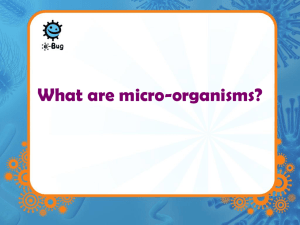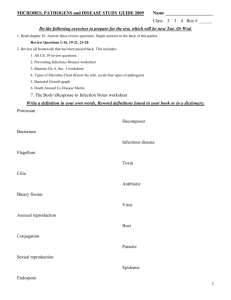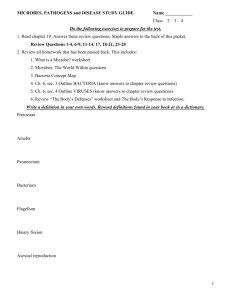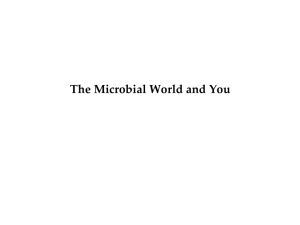- 2 basic types - includes protozoa and fungi
advertisement
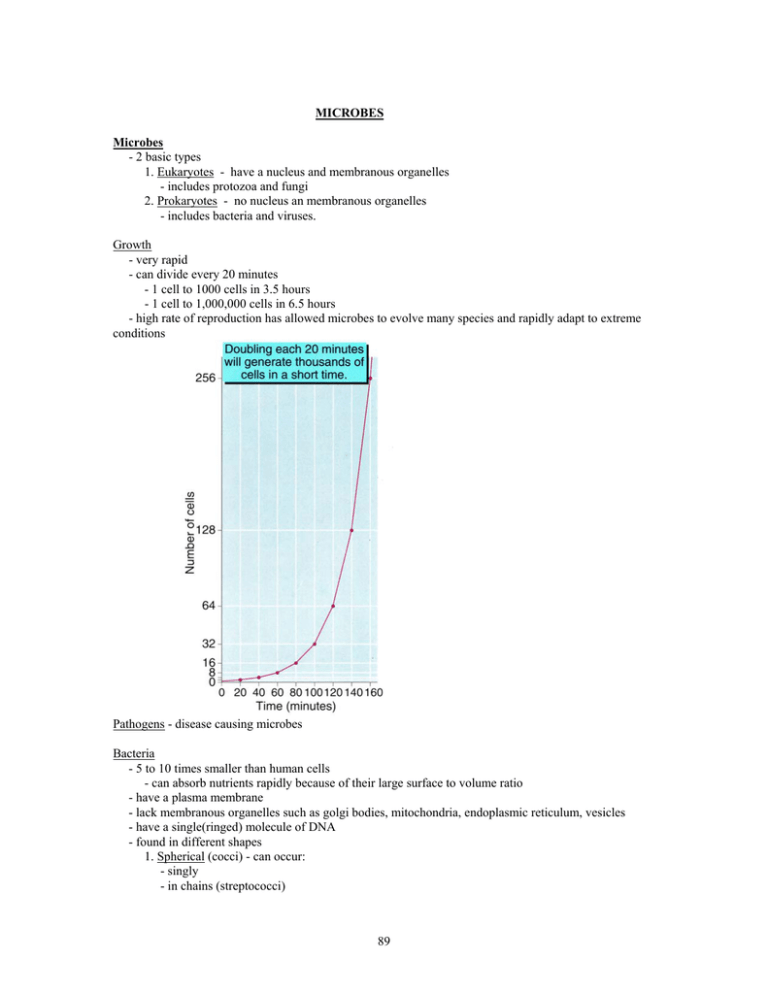
MICROBES Microbes - 2 basic types 1. Eukaryotes - have a nucleus and membranous organelles - includes protozoa and fungi 2. Prokaryotes - no nucleus an membranous organelles - includes bacteria and viruses. Growth - very rapid - can divide every 20 minutes - 1 cell to 1000 cells in 3.5 hours - 1 cell to 1,000,000 cells in 6.5 hours - high rate of reproduction has allowed microbes to evolve many species and rapidly adapt to extreme conditions Pathogens - disease causing microbes Bacteria - 5 to 10 times smaller than human cells - can absorb nutrients rapidly because of their large surface to volume ratio - have a plasma membrane - lack membranous organelles such as golgi bodies, mitochondria, endoplasmic reticulum, vesicles - have a single(ringed) molecule of DNA - found in different shapes 1. Spherical (cocci) - can occur: - singly - in chains (streptococci) 89 - in clusters (staphylococci) 2. Rod shaped (bacilli) - occur singly 3. Curve shaped (spirilla) - often occur singly - have a rigid cell wall that surrounds the plasma membrane - can form endospores in unfavorable conditions - some have external structures such as: - capsules - cover the entire bacteria and protect from phagocytosis. - flagella - for movement - pili - for attaching to tissue cells - example: Neisseria gonorrhoeae attaches to cells of urinary tract - can’t be washed away in urine Fungi - eukaryotes - fungal wall is made of chemicals that are not affected by antibiotics - most are multicellular with long branches called filaments - do not have flagella - release spores in large numbers that germinate and develop filaments that release chemicals that breaks down the substrate they are on (for example athletes foot) - over 100,000 species on earth - about 100 are human pathogens - most are passed on to other humans by exposure to air, dust, or soil contamination. - ringworm and yeast infections passed on by contact Protozoa - eukaryotes - single celled - 20,000 species known - 30 cause human diseases (such as malaria) - most have flagella or pseudopodia for movement - under bad conditions can form cysts that can live for centuries. 90 Viruses - consist of a molecule of nucleic acid surrounded by a protein coat - lack organelles and energy enzymes needed for growth, maintenance and reproduction - to reproduce must enter a host cell - host cell reproduces the virus - some use DNA for their hereditary material - warts, herpes, hepatitis B, mononucleosis, chicken pox - some use RNA for their hereditary material - colds, AIDS, mumps, measles, influence, polio Microbes beneficial to humans - is microbes normally reside on the human body without causing disease they are called normal flora - includes some bacteria, fungi and protozoa - you acquire the normal flora after birth from the environment - examples: - E. coli in bacteria help to break down undigested foods and synthesize some vitamins. - effective in maintaining a local environment that prevents pathogenic invasion 91 Microbes working in industry - pure cultures (one type of organism) are required - medical products produced include antibiotics, vaccines, hormones, and steroids - food products produced include yogurt, buttermilk, sour cream, cheese, breads etc. Microbes working in the environment - photosynthetic bacteria act as producers to make carbohydrates - decomposers break down dead producers to release carbon dioxide Pathogenic Microbes - are capable of growing in human tissues and causing diseases - most are mild to moderate pathogens and are quickly controlled by the bodies defenses. - some like those causing rabies, cholera and plague can overwhelm the bodies defenses. - some only infect us when an opportunity arises (opportunistic pathogens) like pneumocystic pneumonia in AIDS patients. How do pathogens enter the body - through portals of entry such as breaks in the skin or through exposed mucous membranes of the eye, respiratory tract, digestive tract, reproductive tract, urinary tract. - some pathogen have specific areas of entry - such as cold viruses that enter through the respiratory tract. How are pathogens transmitted - by passing directly from an infected host - by contact with contaminated objects - by almost any means possible to imagine. - called communicable disease if passed directly or indirectly from another host - examples: cold, flu, AIDS etc. - called non-communicable disease if not acquired directly or indirectly from another animal - examples: gas gangrene, botulism, tetanus etc. How do pathogens make us ill - pathogens enter a tissue area, multiply in number, and cause tissue damage. - tissue damage alters body physiology and produces the symptoms of the disease. Bacteria - produce and release enzymes and chemical toxins that help them invade and destroy tissues - destroyed cells provide the bacteria with nutrients - there are two categories of bacterial toxins: 1. those produced and released by living bacteria. These can be: a. pathogenic bacteria like cholera and tetanus infecting the body - cholera enter the G.I. tract with contaminated food - they produce a toxin that irritates the mucosal lining - leading to diarrhea - tetanus bacteria enters the body through a wound - they produce a toxin that affects the nerves going to skeletal muscles - leading to spasms - staph food poisoning (ptomaine poisoning) - the toxin is produced by staphylococcus bacteria growing on food - the toxin irritates the G.I. tract causing vomiting, nausea, and diarrhea. 2. those produced and released by dead, disintegrating bacteria - associated with the bacteria that produce salmonellosis - the toxin cause fever, weakness, intestinal bleeding, and even shock. 92 Viruses - reproduce by entering a living host cell - viruses DNA (or RNA) directs the host cell to reproduce the virus - symptoms of viral disease depend on the type of host cell infected, damaged and killed - viral infection can be divided into 4 phases: - attachment - protein of virus envelope binds to protein receptors on host cell membrane - penetration - virus envelope fuses with plasma membrane, and virus capsid and nucleic acid enter the host cell. Capsid disintegrates and nucleic acid is released. - biosynthesis and assembly - Copies of viral nucleic acid are replicated. Viral nucleic acids is used to synthesize new capsid proteins by employing organelles of host cell. Newly synthesized capsid proteins and viral nucleic acid molecules are assembled into new viruses. - release - viruses with envelopes are released from the host cell. - in some instances the viral DNA may become part of the host cell’s DNA. This is called viral integration. The Viral DNA will remain there for the life of the cell. Every time the host cell replicates itself the viruses are also replicated. The human immunodeficiency virus (HIV) is one such virus. Fungi - are similar to bacteria in their mechanisms of infection - they release enzymes and chemical toxins to invade and digest tissues. - pathogenic fungi get into the body through two main portals: 1. the respiratory system. - histoplasmosis is a good example. This fungi is common in areas with bird droppings. 2. the skin. - ringworm (athletes foot) is a fungi that releases an enzyme that breaks down the keratin of the skin, hair and nails 93 Protozoa - infect the intestinal tract, brain, liver, and blood - amoebic dysentery and giardiasis are two examples of protozoa infections of the G.I. tract. The adult protozoans are killed by stomach acid but the cysts live to enter the intestines where they cause diarrhea, abdominal cramps, and nausea. - malaria is also caused by protozoans. The enter the body through mosquito bite and infect RBC’s. Control of microbes - sterilization destroys all the microbes - pasteurization reduces their numbers significantly - physical methods - microbes require specific conditions of moisture, temperature, pH and O2 or CO2 to exist - changes in any of these variables may kill certain kinds of microbes - table 12.3 on page 327 summarize the different physical methods of controlling microbes. - chemical methods - if used on a none living surface, microbe killing chemicals are called disinfectants. - if used on body surfaces called antiseptics - disinfectants and antiseptics such as alcohol, chlorine and iodine can attack the microbe by destroying its cell membrane, DNA, and/or proteins. - common household bleach can be used to purify water of microbes Antibiotics - interfere with cellular processes and structure unique to bacteria (and do not act on cells lacking these structures) - for example: - penicillin interferes with the production of bacterial cell walls - tetracycline and erythromycin inhibit bacterial protein synthesis Antibiotic resistance - over use of antibiotics has led to evolution of bacteria who are immune to these antibiotics - new antibiotics must be produced that these microbes have never encountered. 94
